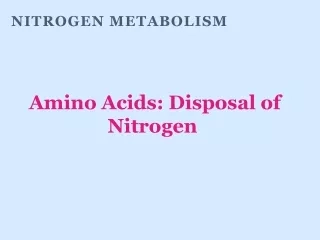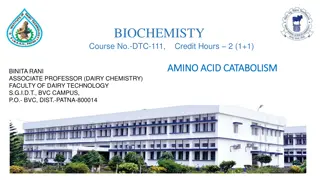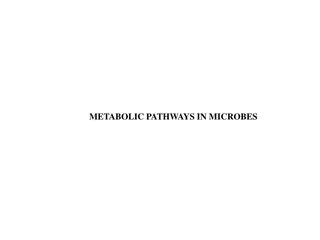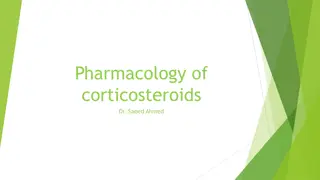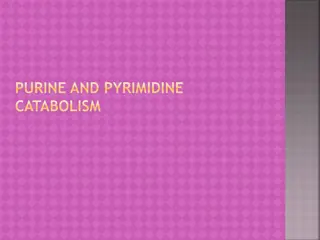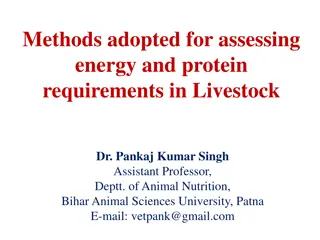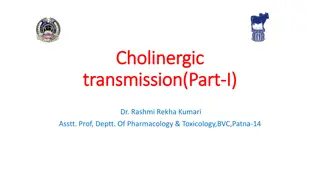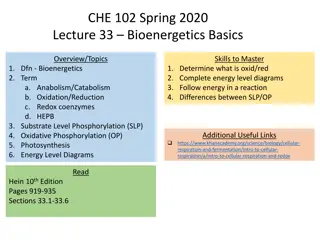Amino Acids: Disposal of Nitrogen
Overview of nitrogen metabolism with a focus on the disposal of nitrogen through amino acid catabolism. It explains the process of removing the α-amino groups from amino acids, the synthesis of urea, and the conversion of carbon skeletons to energy-producing pathways.
36 views • 65 slides
Understanding Plasma Proteins and Their Functions
Plasma proteins play a crucial role in various physiological functions such as controlling extracellular fluid distribution and transportation of hormones, vitamins, and other substances. The balance between protein synthesis and catabolism determines protein levels in the vascular compartment, affe
6 views • 23 slides
Regulation of Energy Homeostasis by AMPK System and Its Modulation Factors
The AMPK system plays a crucial role in regulating energy homeostasis by sensing the cellular AMP:ATP ratio and responding to metabolic stresses that affect ATP production or consumption. AMPK is activated by factors such as hypoxia, glucose deprivation, and metabolic inhibitors, as well as by compo
0 views • 27 slides
Understanding Cellular Respiration and Metabolism in Living Organisms
Cellular respiration is a vital process in all living cells, producing energy through chemical reactions. Metabolism, consisting of anabolism and catabolism, maintains growth and function. ATP plays a central role as energy currency in cells. Through stages like glycolysis and the Krebs cycle, cellu
1 views • 16 slides
Amino Acid Catabolism: Pathways and Reactions
Amino acid catabolism involves removing amino groups via deamination, leading to urea synthesis and TCA cycle intermediates. The process includes transamination and oxidative deamination reactions, with specific aminotransferases catalyzing these reactions. Transamination is a key step in funneling
0 views • 23 slides
Understanding Metabolic Pathways in Microbes
Metabolism in living organisms involves anabolism and catabolism, where anabolism generates essential biomolecules for growth using energy, while catabolism breaks down nutrients for energy release. Anabolic processes include synthesis of carbohydrates, lipids, proteins, nucleic acids, and other gro
7 views • 24 slides
Understanding Corticosteroids: Pharmacology and Effects
Corticosteroids, including glucocorticoids and mineralocorticoids, play vital roles in intermediary metabolism, immune responses, and inflammation regulation. They bind to specific receptors in the cell, entering the nucleus to influence gene transcription and protein production. These hormones have
15 views • 32 slides
Understanding Purine and Pyrimidine Metabolism in Genetic Disorders
Explore the intricate pathways of purine and pyrimidine catabolism, salvage, and degradation. Uncover the causes and symptoms of genetic disorders like Lesch-Nyhan Syndrome and Gout. Discover the importance of ribonucleotides conversion to deoxyribonucleotides in DNA synthesis. Dive into the mechani
0 views • 18 slides
Understanding Energy and Protein Requirements in Livestock
Assessing the energy and protein requirements in livestock is crucial to ensure optimal health and productivity. Dr. Pankaj Kumar Singh, Assistant Professor at Bihar Animal Sciences University, explains the significance of determining energy and protein needs for maintenance, metabolic processes, an
1 views • 21 slides
Understanding Cholinergic Transmission in Neurohumoral Signaling
Cholinergic transmission plays a crucial role in neurohumoral signaling, involving the release of acetylcholine at synapses and neuroeffector junctions. Dr. Rashmi Rekha Kumari explains the synthesis, storage, release, and catabolism of acetylcholine, highlighting the role of choline acetyl transfer
0 views • 11 slides
Understanding Purine Degradation and Gout
Purine degradation pathway involves the breakdown of dietary nucleic acids, mainly from meat, into uric acid through specific enzymatic steps. Excessive uric acid production can lead to conditions like gout and hyperuricemia. Humans excrete uric acid in the urine as the final product, while other an
1 views • 12 slides
Bioenergetics Basics: Overview, Topics & Energy Diagrams
The content covers the fundamentals of bioenergetics, including topics like anabolism, catabolism, oxidation, reduction, redox coenzymes, substrate-level phosphorylation, oxidative phosphorylation, and photosynthesis. It also explores energy level diagrams, metabolism, oxidation-reduction reactions,
0 views • 21 slides
